Salamanders in Florida enjoy the state’s warm climates, moist areas, natural springs, and optimal aquatic habitats. In fact, the entire southeastern area in the United States ranks as having a large diversity of North American salamanders.
The term salamander is a common name used to describe a population of animals consisting of six different family species, including true salamanders, newts, sirens, and amphiumas. Let’s learn more about the 26 species of salamanders you can find in Florida!
26 Salamanders in Florida
The 26 different species of salamanders in Florida are theFlatwoods Salamander, Reticulated Flatwoods Salamander, Mole Salamander, Apalachicola Dusky Salamander, Southern Dusky Salamander, Spotted Dusky Salamander, Southern Two-lined Salamander, Three-lined Salamander, Tiger Salamander, Marbled Salamander, Seal Salamander, Dwarf Salamander, Georgia Blind Salamander, Four-toed Salamander, Southeastern, Slimy Salamander, Mud Salamander, Southern Red Salamander, Loding’s Waterdog, Gulf Coast Waterdog, Striped Newt, Eastern Newt, Eastern Lesser Siren, Greater Siren, Dwarf Siren, One-toed Amphiuma, and Two-toed Amphiuma.
1. Flatwoods Salamander

Scientific name: Ambystoma cingulatum
As its name suggests, the Flatwoods salamander enjoys the pine flatwood habitats of the coastal plains in northern Florida. These salamanders are between 3.5 to 5 inches in length, with short legs and a rounded tail. They spend most of their time underground, especially in crayfish burrows.
2. Reticulated Flatwoods Salamander
Scientific name: Ambystoma bishopi
You can find the Reticulated Flatwoods salamander in the western panhandle of Florida in pine flatwoods and savanna habitats. They look almost identical to the flatwood salamander, including can grow up to 5 inches in length. They also similarly breed in wetlands with extensive vegetation.
3. Mole Salamander

Scientific name: Ambystoma talpoideum
The Mole salamander can grow up to 4 inches long and are usually gray or dark brown, with lighter underbellies. You can find them in northern Florida only. These salamanders prefer living in leaf litter on the forest floor and other moist forest debris near permanent water bodies such as ponds.
4. Apalachicola Dusky Salamander
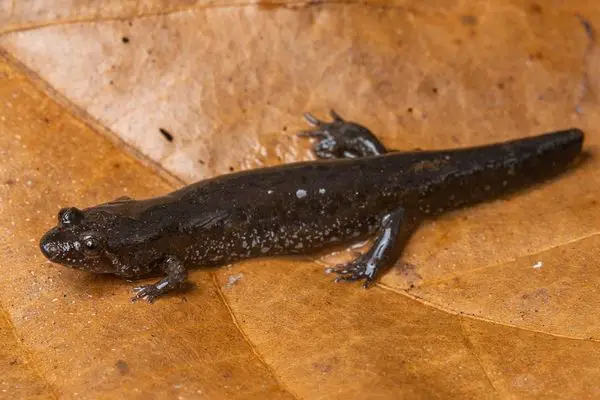
Scientific name: Desmognathus apalachicolae
Apalachicola Dusky salamanders are a threatened species due to habitat loss and their limited range. You can find them in a small area in the Florida panhandle, where they prefer freshwater springs, temperate forests, and intermittent rivers. They are typically brownish to gray and can grow an average of 4 inches in length.
5. Southern Dusky Salamander
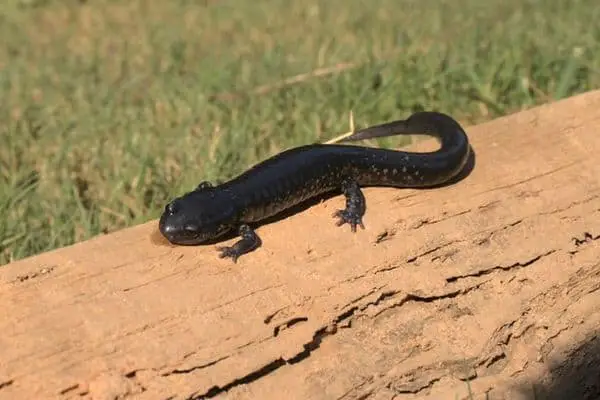
Scientific name: Desmognathus auriculatus
The Southern Dusky salamander grows between 3 to 6 inches long and is black to dark brown with rear legs significantly larger than their front legs. These salamanders can be found near the coastal areas or in swamps or flood plain habitats of Florida.
6. Spotted Dusky Salamander

Scientific name: Desmognathus conanti
You can find the Spotted Dusky salamander only in the far western areas of the Florida panhandle. They prefer habitats with lower mountain elevations, small rivers, and cool streams. Growing between 2.5 to 5 inches long, these salamanders typically have 6 to 8 pairs of spots that can fuse in adulthood to form a light stripe with a dark border.
7. Southern Two-lined Salamander

Scientific name: Eurycea cirrigera
Southern two-lined salamanders are very small, with narrow bodies averaging 2.5 to 3.75 inches in length. They are light yellow to tan with two dark stripes running down their backs. You can find them throughout most of the Florida panhandle beside flowing streams or creeks.
8. Three-lined Salamander
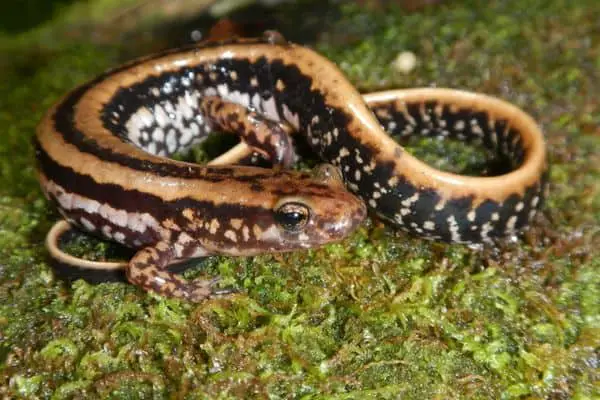
Scientific name: Eurycea guttolineata
Three-line salamanders live throughout peninsular Florida, preferring to hide under rocks, wood, and other covers beside streams and swamps. They are yellow or tan with three bold dark stripes running down their backs. These salamanders grow between 4 to 6.25 inches in length.
9. Tiger Salamander
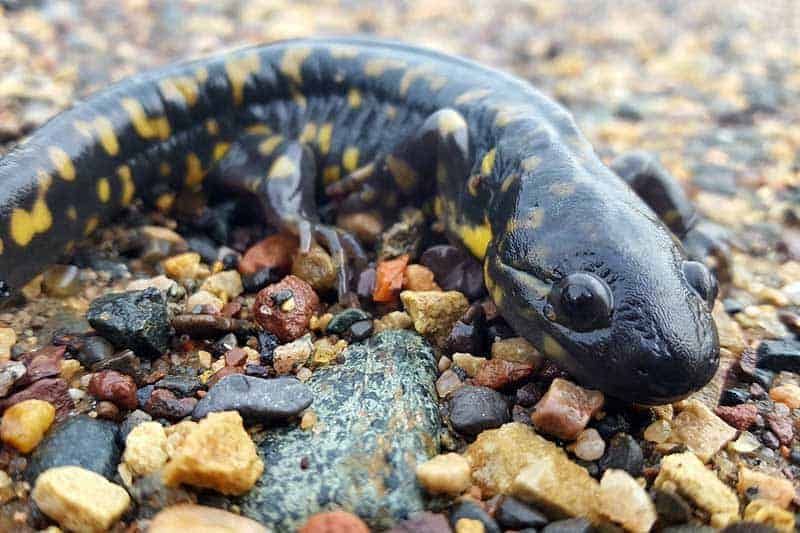
Scientific name: Ambystoma tigrinum
The Tiger salamander is larger than most on this list, growing an average of 6 to 8 inches in length. Their distinct greenish-yellow to brownish-yellow spots on their black or dark brown bodies resemble a tiger. You can find them mostly along the Atlantic coast of Florida.
10. Marbled Salamander
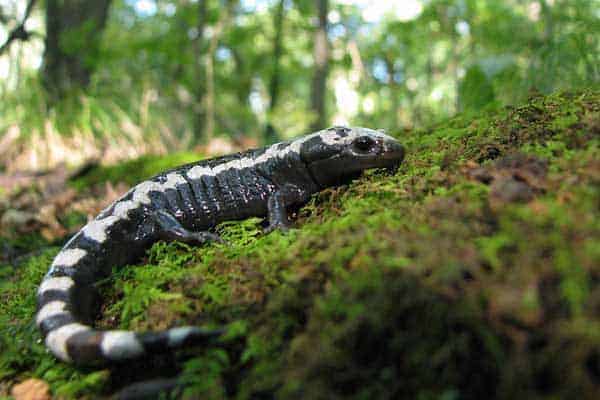
Scientific name: Ambystoma opacum
The Marbled salamander has a beautiful pattern, as its name suggests. They have bold grey or white bands against blackish bodies. These salamanders grow up to 4 inches and prefer hiding in burrows or under logs in northern Florida.
11. Seal Salamander
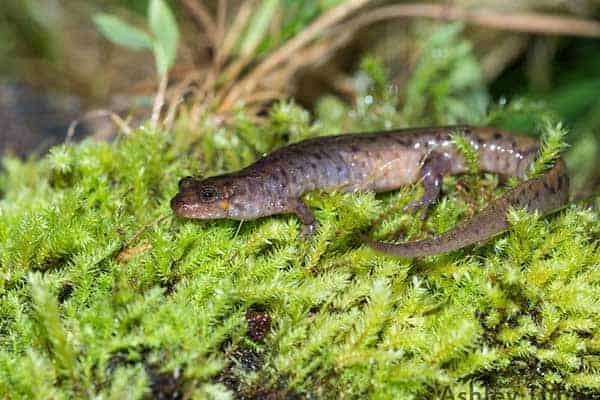
Scientific name: Desmognathus monticola
Although commonly found in the Appalachians, the Seal salamander also lives in the far western areas of the Florida panhandle. They prefer cold waters of streams, rivers, and seepage slopes. These salamanders are mottled dark brown and average at 3 to 5 inches in length but can grow up to 8 inches.
12. Dwarf Salamander

Scientific name: Eurycea quadridigitata
Dwarf salamanders are small four-toed animals growing around 2 to 3.5 inches long. They have a slender body and dark blotches and stripes on their yellow-brown color. These salamanders prefer swampy pine woods in northern Florida.
13. Georgia Blind Salamander
Scientific name: Eurycea wallacei
These unique salamanders have no eyes and can be found only in dark caves in a small area of the Florida panhandle. The Georgia Blind salamander is white with a pink or yellowish tint and grows to only 2 inches in length. They also have bright red external gills on their heads.
14. Four-toed Salamander
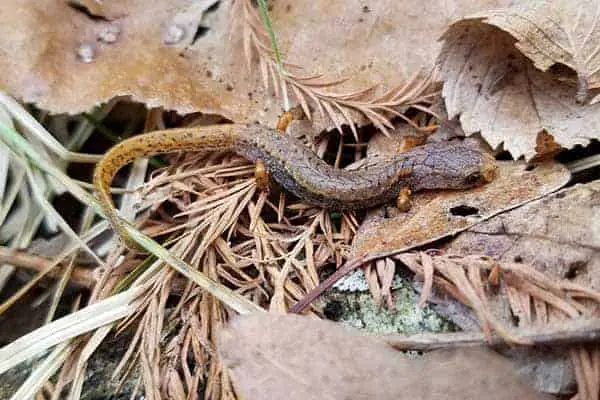
Scientific name: Hemidactylium scutatum
Besides its four-toes, the Four-toed salamander has a distinctive white belly with black dots. This salamander is typically smaller than 3.9 inches long and often detaches its tail to run from predators. In Florida, you can find them in limited areas of the panhandle in floodplains, boggy streams, or bogs.
15. Southeastern Slimy Salamander

Scientific name: Plethodon grobmani
The Southeastern Slimy salamander lives throughout Florida, except for the southern regions of the state. They prefer moist wooded ravines and woodlands. Their color is brackish-blue with scattered light spots and they grow up to 6.75 inches in length.
16. Mud Salamander
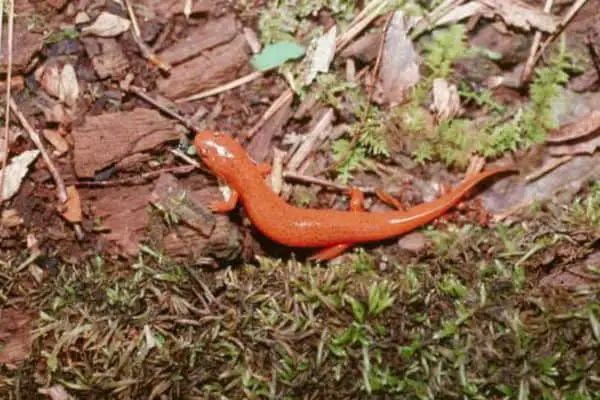
Scientific name: Pseudotriton montanus
You can find Mud salamanders in northern Florida and the panhandle along slow-flowing creeks or by muddy springs. They are reddish as juveniles and become rusty brown as adults. These bulky salamanders can grow to 6.5 inches in length.
17. Southern Red Salamander
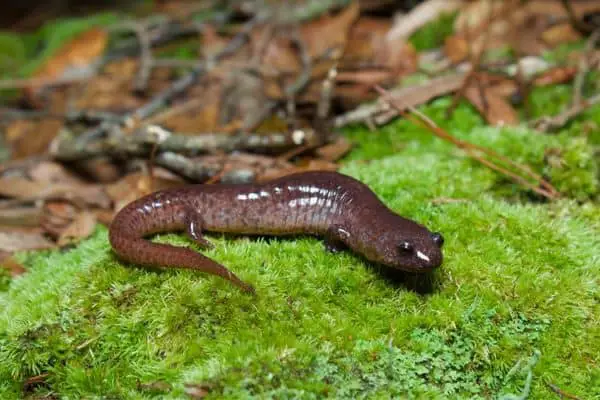
Scientific name: Pseudotriton ruber
As their name suggests, the Southern Red salamander is bright red to reddish-orange with black spots. They grow up to 6 inches and are known to eat other salamanders on top of small vertebrates and invertebrate prey. In Florida, they are only found in the panhandle.
18. Loding’s Waterdog
Scientific name: Necturus lodingi
Waterdogs are generally aquatic salamanders. Although the Loding’s waterdog has different markings, it is sometimes considered the same species as the Alabama waterdog (Necturus alabamensis). However, this species can be found in the Florida panhandle, while the Alabama waterdog typically refers to the species only from Alabama’s Cumberland Plateau.
19. Gulf Coast Waterdog
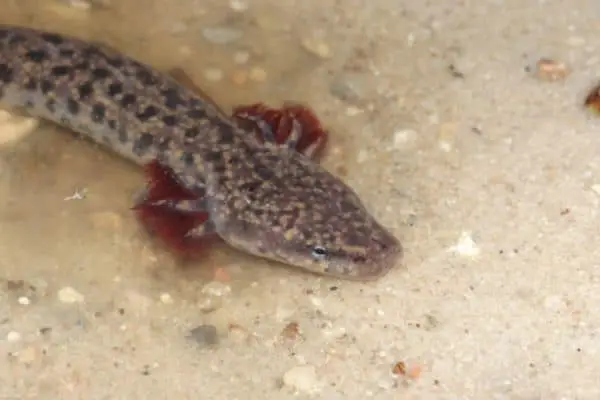
Scientific name: Necturus beyeri
The Gulf Coast waterdog is an undescribed species of waterdog that can be found in Florida’s panhandle. Similar to the Loding’s waterdog, they are commonly sold at pet stores as Alabama waterdogs. These salamanders are aquaticand can grow between 5 to 8 inches in length.
20. Striped Newt

Scientific name: Notophthalmus perstriatus
The Striped newt has a small range in northeastern Florida, where they prefer pine sandhills and scrub habitats and, for breeding, wetlands. They have dark red stripes along their olive-brown backs and can grow between 2 to 4 inches long.
21. Eastern Newt

Scientific name: Notophthalmus viridescens
The Eastern newt, also known as the Red-Spotted newt, can be found throughout Florida in permanent or semi-permanent water bodies. Despite its name, its color ranges from red to olive green or yellowish-brown in order to camouflage into its environment.
22. Eastern Lesser Siren
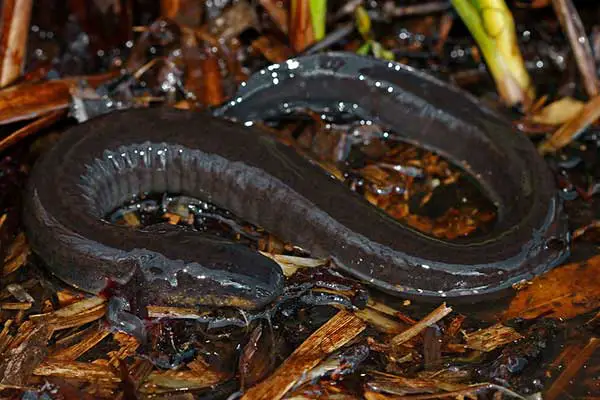
Scientific name: Siren intermedia
Sirens are a type of salamander that looks snake-like and has no hind limbs. They are also aquatic and maintain their external gills throughout their lives. The Eastern Lesser siren can be found in northern Florida, including the panhandle in lakes, ditches, ponds, and streams. Both the eastern and western varieties (pictured above) are found in the eastern U.S. and Mexico.
23. Greater Siren
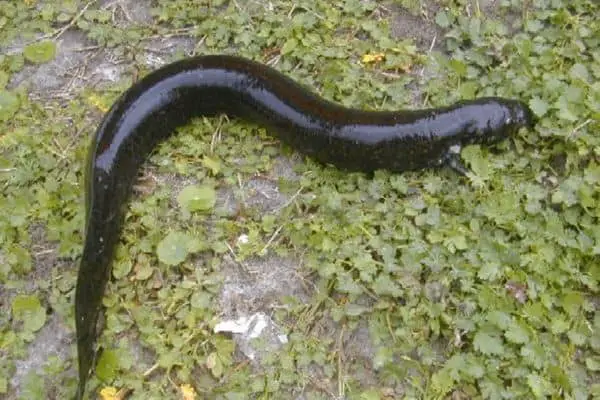
Scientific name: Siren lacertina
The Greater Siren is the largest salamander species in Florida. They can grow between 19 to 27 inches in length and resemble an eel with a flattened tail. You can find these salamanders throughout Florida.
24. Dwarf Siren

Scientific name: Pseudobranchus striatus
The Dwarf siren is the smallest siren in Florida, growing to around 4 to 6 inches in length. They are sluggish and uniquely have three front toes with their absent hind limbs. You can find these salamanders throughout Florida in habitats with the exotic plant called the water hyacinth.
25. One-toed Amphiuma

Scientific name: Amphiuma pholeter
Although they look more like snakes, amphiumas are a species of aquatic salamanders, and they do have four tiny legs, unlike snakes. The One-toed amphiuma gets its name from the one toe at the end of its legs. These salamanders grow an average of 8.5 inches in length. You can only find them in the Florida panhandle, where they are most active at night.
26. Two-toed Amphiuma
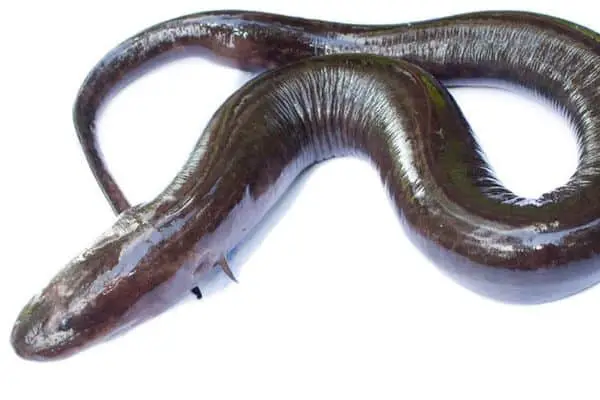
Scientific name: Amphiuma means
The Two-Toed amphiuma differs from the one-toed by the number of toes at the end of their minuscule legs. They also have lighter underbellies. These salamanders have very slippery skins and prefer the water, leaving only if the weather on land is wet enough. You can find them in the northern area of Florida.




